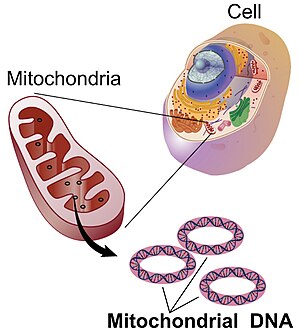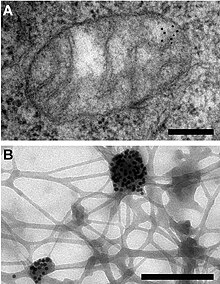

Mitochondrial DNA (mtDNA and mDNA) is the DNA located in the mitochondria organelles in a eukaryotic cell that converts chemical energy from food into adenosine triphosphate (ATP). Mitochondrial DNA is a small portion of the DNA contained in a eukaryotic cell; most of the DNA is in the cell nucleus, and, in plants and algae, the DNA also is found in plastids, such as chloroplasts.[3]
Human mitochondrial DNA was the first significant part of the human genome to be sequenced.[4] This sequencing revealed that human mtDNA has 16,569 base pairs and encodes 13 proteins. As in other vertebrates, the human mitochondrial genetic code differs slightly from nuclear DNA.[5]
Since animal mtDNA evolves faster than nuclear genetic markers,[6][7][8] it represents a mainstay of phylogenetics and evolutionary biology. It also permits tracing the relationships of populations, and so has become important in anthropology and biogeography.
- ^ Siekevitz P (1957). "Powerhouse of the cell". Scientific American. 197 (1): 131–40. Bibcode:1957SciAm.197a.131S. doi:10.1038/scientificamerican0757-131.
- ^ Iborra FJ, Kimura H, Cook PR (May 2004). "The functional organization of mitochondrial genomes in human cells". BMC Biology. 2: 9. doi:10.1186/1741-7007-2-9. PMC 425603. PMID 15157274.
- ^ Sykes B (10 September 2003). "Mitochondrial DNA and human history". The Human Genome. Wellcome Trust. Archived from the original on 7 September 2015. Retrieved 5 February 2012.
- ^ Anderson S, Bankier AT, Barrell BG, de Bruijn MH, Coulson AR, Drouin J, et al. (April 1981). "Sequence and organization of the human mitochondrial genome". Nature. 290 (5806): 457–465. Bibcode:1981Natur.290..457A. doi:10.1038/290457a0. PMID 7219534. S2CID 4355527.
- ^ Chinnery, Patrick Francis; Hudson, Gavin (June 2013). "Mitochondrial genetics". British Medical Bulletin. 106 (1): 135–159. doi:10.1093/bmb/ldt017. ISSN 0007-1420. PMC 3675899. PMID 23704099.
- ^ Boursot P, Bonhomme F (1 January 1986). "[Not Available]". Génétique, Sélection, Évolution. 18 (1): 73–98. doi:10.1186/1297-9686-18-1-73. PMC 2713894. PMID 22879234.
- ^ Delsuc F, Stanhope MJ, Douzery EJ (August 2003). "Molecular systematics of armadillos (Xenarthra, Dasypodidae): contribution of maximum likelihood and Bayesian analyses of mitochondrial and nuclear genes". Molecular Phylogenetics and Evolution. 28 (2): 261–275. Bibcode:2003MolPE..28..261D. doi:10.1016/s1055-7903(03)00111-8. PMID 12878463. Archived from the original on 4 November 2018. Retrieved 4 November 2018.
- ^ Hassanin A, An J, Ropiquet A, Nguyen TT, Couloux A (March 2013). "Combining multiple autosomal introns for studying shallow phylogeny and taxonomy of Laurasiatherian mammals: Application to the tribe Bovini (Cetartiodactyla, Bovidae)". Molecular Phylogenetics and Evolution. 66 (3): 766–775. Bibcode:2013MolPE..66..766H. doi:10.1016/j.ympev.2012.11.003. PMID 23159894.